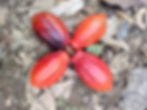Chuncho
Source: Co-operative and directly with farmers
Region: Southern Peru – Andes/Amazon
Department: Cusco
Elevation: 400-1200m
Yearly Rainfall: ~2200mm (87 inches)
Genetics: Native Chunchos (Clasico, Senhorita, Pamuco Rugoso, Cascara de Huevo, Achoccha, Blanco, Pamuco, Emilia)
Harvest Season: Mar - Jul
Tasting Notes: Floral and pronounced fruity flavours: tropical and some red fruits. Very low astringency and tannins.
Fermentation Style: 4-5 days in wooden boxes; daily bean rotation after the first 2 days.
Drying Style: 2-4 days in mounds while drying, then dispersed over tarped floor or drying shelves for 3-4 days.




One of the world’s most interesting origins for its bold and highly diverse fruit and floral flavour profile, its higher fat content (~56-58%), and almost no astringency nor tannins. While some can be found in the VRAE region, the Chuncho bean is native to the department of Cusco and has been classified as its own genetic variety cluster. It’s the same cacao the Incas used to eat centuries ago that will lay the foundation to your sublime chocolate creations.
Before the arrival of Christopher Columbus, Cusco was the region with the highest cacao production in Peru. After colonization, and hundreds of years of commercialization, the northern jungle departments overtook this region from a cacao output standpoint, but not of the Chuncho bean. It has stayed put, primarily in the extremely-isolated Urubamba Valley, which kept the Chuncho bean genetically unadulterated—the main reason why this bean is so highly sought after.
If you’re wondering what the Urubamba Valley is, it’s the main valley the Incas would traverse to get from the Andes to the jungle to trade with the Amazonians. A rich and fertile land that’s currently home to several co-operatives, two of which we’ve had the pleasure of working with for years. Here, and in the surrounding areas, farmers work together to harvest the yellow to rose coloured Chuncho pods separately from other Cusco varieties and bring them back to their co-op’s fermenting centre where they begin the roughly 12-day fermenting and drying process. From there, after our quality requirements are met, they are transported
to our plant on the coast where they undergo an additional QA process, manual selection, and are
prepared for exporting.
A well-oiled machine that wouldn’t be possible without the coordination of the Alto Urubamba co-op that have forged strong, empowering relationships with their farmers.
Furthermore, some farmers in the region have taken it a step further, producing chocolate thanks in part to a little help from us, who provided them with free chocolate making workshops and some gifted/subsidized DCM Premier Refiners. Now, it may not seem that special for farmers to make their own chocolate, but it’s extremely rare in Peru (and other cacao producing countries). They’ve become trailblazers, spurring other farmers in Cusco to do the same. This is good for everyone. As more farmers bridge the gap to chocolate making, they’ll begin to build their own chocolate brands and not only add another revenue stream, but also fine-tune their harvesting, fermenting, and drying processes to improve the quality of (and the demand for) the cacao they use and export to the world.
We’re confident that when you try this bean in your chocolate making, you’ll quickly see why it’s so coveted.
5kg boxes available in our shop. For any other volumes please contact us.
